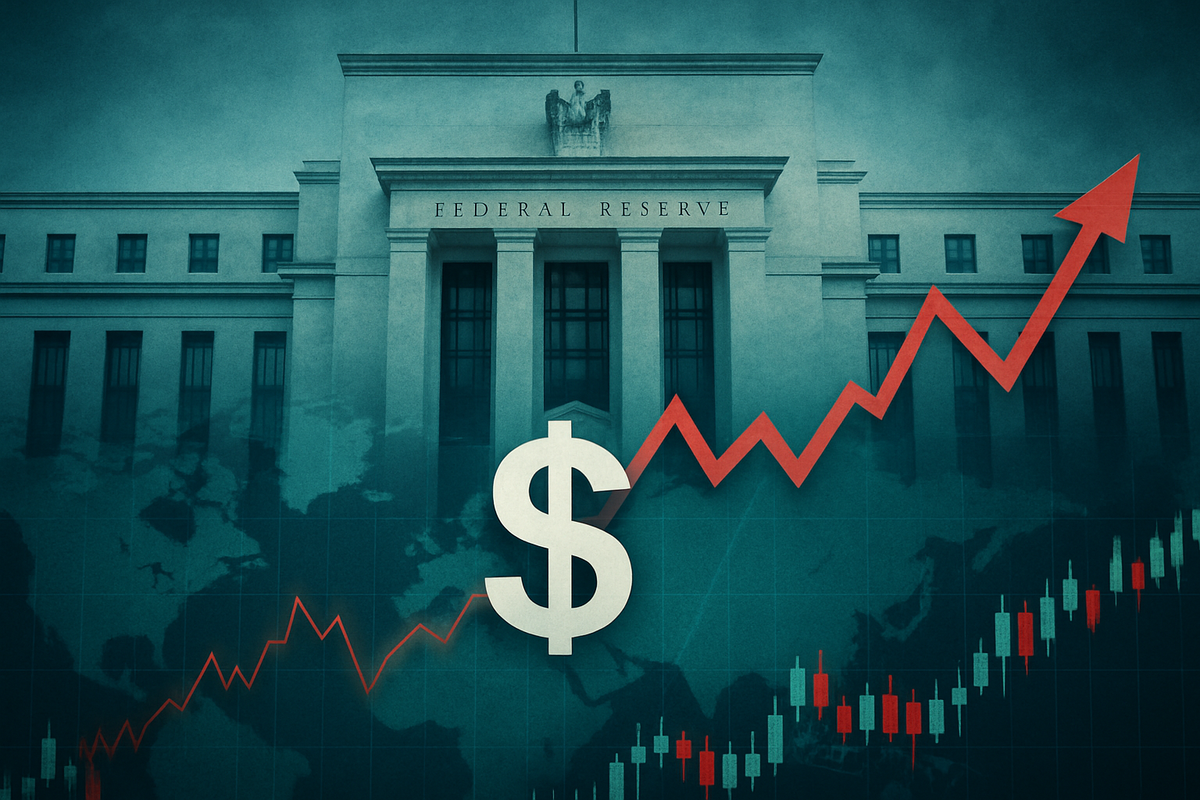
Washington D.C. – October 30, 2025 – The Federal Reserve, yesterday, delivered a widely anticipated 25-basis-point interest rate cut, bringing the federal funds rate to a target range of 3.75%-4.00%. This marks the second consecutive reduction in 2025, signaling a response to a softening labor market and ongoing economic adjustments. However, the celebratory mood among investors was swiftly tempered by Federal Reserve Chair Jerome Powell's post-meeting press conference, where his unexpectedly hawkish remarks cast a significant shadow over the prospect of further easing, sending ripples of uncertainty through global financial markets.
Powell's cautious stance, emphasizing that a December rate cut is "not a foregone conclusion" and highlighting "strongly differing views" among committee members, has triggered a dramatic recalibration of investor expectations. What was largely perceived as a clear path towards a sustained easing cycle has now become a landscape fraught with doubt, impacting bond yields, strengthening the US dollar, and introducing a fresh wave of volatility into equity markets as participants grapple with the Fed's divided outlook and mixed economic signals.
A Hawkish Twist to a Dovish Move
The Federal Open Market Committee (FOMC) voted 10-2 on October 29, 2025, to lower the benchmark interest rate by 25 basis points, a move largely priced in by the markets. This decision was influenced by a weakening labor market, characterized by slowing job gains and a slight uptick in the unemployment rate, despite overall economic activity expanding at a moderate pace. In addition to the rate cut, the Fed announced a cessation of its balance sheet reduction (quantitative tightening) starting December 1, 2025, by reinvesting maturing mortgage-backed securities into Treasury bills – a move typically seen as accommodative.
However, the narrative shifted dramatically during Chair Jerome Powell's subsequent press conference. Despite the rate cut, Powell adopted a distinctly hawkish tone, explicitly stating that a further rate cut in December is "far from it" and not a certainty. This statement directly contradicted market expectations, which, prior to the meeting, had placed a high probability (around 90-94% via the CME FedWatch Tool) on another 25-basis-point reduction in the final meeting of the year. The internal divisions within the FOMC were also highlighted by the dissenting votes: Governor Stephen Miran advocated for a larger 50-basis-point cut, while Kansas City Fed President Jeffrey Schmid preferred to keep rates unchanged, citing persistent inflation concerns. Inflation remains "somewhat elevated," with the Consumer Price Index (CPI) rising to 3% for the 12 months ending September 2025, partly due to tariffs contributing to higher goods inflation. The ongoing federal government shutdown has further complicated economic assessments, delaying key data releases and forcing the Fed to rely on alternative metrics.
The immediate aftermath of Powell's comments saw a swift and decisive market reaction. The implied probability of a December rate cut plummeted from over 90% to a range of approximately 33.3% to 67%, reflecting the sudden increase in uncertainty. Bond yields surged, with the 10-year US Treasury yield rising to around 4.05%, breaching a psychological 4% barrier, and 2-year Treasury yields increasing to 3.6%. The US dollar strengthened against a basket of major currencies, while US stock indexes, including the S&P 500 (SPX) and Dow Jones Industrial Average (DJIA), pared earlier modest gains or dipped into negative territory. Overall market sentiment has pivoted from anticipating a predictable easing cycle to one of heightened caution, as investors digest the Fed's conflicting signals and the complexities of the current economic environment, which some analysts describe as containing elements of "mild stagflation."
Shifting Fortunes: Who Wins and Who Loses in a Higher-for-Longer Rate Environment
The Federal Reserve's commitment to a potentially prolonged period of elevated interest rates, despite yesterday's cut, is poised to reshape the competitive landscape across various industries, creating distinct winners and losers among public companies. Sectors heavily reliant on borrowing, future growth projections, or discretionary consumer spending are likely to face significant headwinds, while those with strong balance sheets, pricing power, or operating in essential services may find themselves in a more resilient, or even advantageous, position.
The real estate sector, both commercial and residential, is among the most vulnerable. Higher interest rates directly translate to increased borrowing costs for developers and significantly higher mortgage rates for homebuyers, dampening demand and reducing affordability. This impacts homebuilders like PulteGroup (NYSE: PHM) and D.R. Horton (NYSE: DHI), who could see reduced sales and thinner profit margins. Commercial real estate developers and owners, particularly those with exposure to office and retail properties, may struggle with lower valuations, increased vacancy rates, and difficulties refinancing existing debt. Real Estate Investment Trusts (REITs) such as Realty Income Corp (NYSE: O) and NNN REIT Inc (NYSE: NNN) might find their dividend yields less attractive compared to rising fixed-income alternatives, potentially hindering their ability to acquire new properties or maintain profitability.
Technology and growth stocks, especially those highly leveraged or valued primarily on distant future earnings, are also expected to suffer. Higher discount rates diminish the present value of future cash flows, making these companies less appealing to investors. Furthermore, expensive capital makes it costlier for firms like Snowflake (NYSE: SNOW) or Palantir Technologies (NYSE: PLTR) to fund aggressive expansion plans, research and development, and other capital expenditures crucial for their growth models. Smaller, unprofitable tech startups are particularly vulnerable to refinancing risks and a tightening venture capital landscape. Conversely, financial institutions, particularly large commercial banks, stand to benefit. Banks like JPMorgan Chase (NYSE: JPM), Bank of America (NYSE: BAC), and Wells Fargo (NYSE: WFC) typically thrive in a higher rate environment as their net interest margins (NIMs) expand—they can charge more for loans while deposit rates may not rise proportionally.
Consumer discretionary companies are also bracing for impact. As consumers face tighter budgets due to higher borrowing costs (e.g., credit cards, auto loans) and persistent inflation, spending on non-essential goods and services is expected to decline. This could affect restaurant chains like McDonald's (NYSE: MCD) and Starbucks (NASDAQ: SBUX), food delivery services such as DoorDash (NASDAQ: DASH), and retailers of apparel and luxury goods. In contrast, consumer staples companies, which sell essential goods like food, beverages, and household products, tend to be more resilient. Giants like Coca-Cola (NYSE: KO), Hershey (NYSE: HSY), and Procter & Gamble (NYSE: PG) often possess strong brand loyalty and pricing power, allowing them to pass on rising costs to consumers with minimal impact on demand, thereby safeguarding profit margins. Similarly, energy and resources companies, such as ExxonMobil (NYSE: XOM) and Chevron (NYSE: CVX), often perform well during inflationary periods, as commodity prices tend to rise, boosting their revenues and profitability. Lastly, large, cash-rich technology companies like Apple (NASDAQ: AAPL), Alphabet (NASDAQ: GOOGL), and Nvidia (NASDAQ: NVDA), with their substantial cash reserves, can actually benefit from higher interest income on their holdings, making them more resilient than their smaller, less capitalized counterparts.
A Sea Change for the Global Economy: Broader Implications of the Fed's Stance
The Federal Reserve's hawkish posture, signaling a commitment to a "higher-for-longer" interest rate environment, represents a significant inflection point for the global economy, moving beyond mere market fluctuations to fundamentally reshape industry trends, competitive dynamics, and policy considerations. This shift underscores the Fed's unwavering prioritization of price stability, even if it entails a period of slower economic growth and increased financial strain for various sectors.
This sustained period of elevated borrowing costs is poised to profoundly impact several broader industry trends. The real estate and construction sectors will continue to grapple with dampened demand and increased financing expenses, likely leading to a slowdown in new developments and a re-evaluation of existing portfolios. For high-growth technology companies, the era of cheap capital that fueled rapid expansion and innovation is effectively over. Many will face higher hurdles for securing funding, potentially leading to a deceleration in their growth trajectories and a renewed focus on profitability over pure market share. Across the board, leveraged companies, irrespective of sector, will see their interest expenses rise, eroding profit margins and potentially triggering debt restructuring or even insolvencies for those with unsustainable debt burdens. Conversely, companies with robust balance sheets and strong cash flows, particularly in defensive sectors like utilities and consumer staples, are likely to exhibit greater resilience and may even capitalize on opportunities to acquire distressed assets or competitors.
The ripple effects of this hawkish stance extend far beyond individual sectors. The increased cost of capital will likely stifle mergers and acquisitions, reduce capital expenditure plans, and generally temper investment activity across the economy. This could lead to a significant shift in the competitive landscape, favoring established players with ample cash reserves over nimble, but highly leveraged, startups. Globally, a stronger U.S. dollar—a typical consequence of higher U.S. interest rates—will make American exports more expensive and imports cheaper. This also puts considerable pressure on emerging market economies with substantial dollar-denominated debt, increasing their debt servicing costs and potentially triggering capital outflows. Furthermore, the entire supply chain could face increased costs as vendors and suppliers grapple with higher financing expenses, which may ultimately be passed on to consumers.
From a regulatory and policy standpoint, the Fed's actions will likely intensify calls for fiscal prudence from governments, as the cost of servicing national debt rises. Regulators are also expected to increase financial scrutiny on institutions to ensure their resilience against potential economic slowdowns or credit defaults. The Fed's communication strategy will remain hyper-focused on economic data, particularly inflation and labor market statistics, as these will be the primary determinants of future policy adjustments. This period unequivocally highlights the Fed's prioritization of the price stability aspect of its dual mandate, even if it means sacrificing some degree of employment growth in the short term.
Historically, the current situation draws parallels to several periods of aggressive monetary tightening. The most prominent comparison is the Volcker Shock of the late 1970s and early 1980s, where then-Fed Chair Paul Volcker dramatically raised interest rates to combat runaway inflation, albeit at the cost of a severe recession. While the current inflation levels are not as extreme, the Fed's resolve to bring inflation under control mirrors Volcker's determination. Other periods, such as the gradual rate hikes from 2004-2006 or the post-COVID tightening, also serve as reminders that unexpected central bank hawkishness, especially when diverging from market expectations, often leads to increased market volatility and economic adjustments. The present moment underscores the enduring power of central bank policy to reshape economic realities and investor sentiment.
Navigating the New Normal: What Comes Next
The Federal Reserve's recent actions and hawkish forward guidance have ushered in a new era of monetary policy, one where interest rates are likely to remain elevated for a prolonged period compared to pre-pandemic norms. This "higher-for-longer" environment, even amidst recent rate cuts, necessitates significant strategic pivots across businesses, consumers, and financial markets, presenting both formidable challenges and unique opportunities in the months and years ahead.
In the short-term (next 6-12 months), the economy is likely to experience continued moderation. Higher borrowing costs will persist in dampening consumer spending on discretionary items and business investments, particularly in interest-rate-sensitive sectors like retail, hospitality, and durable goods. Inflation, especially core services inflation, may prove sticky, compelling the Fed to maintain its cautious stance on further easing. While the labor market has shown resilience, a continued slowdown in job growth and a modest rise in unemployment could become a more prominent factor influencing the Fed's dovish leanings. Businesses and households will continue to face increased debt servicing costs, raising the specter of defaults for highly leveraged entities. Financial markets, in turn, will remain highly volatile, with every Fed communication and economic data release scrutinized for clues about the future path of rates. A "hawkish cut," where a rate reduction is accompanied by cautious guidance, could lead to fleeting market rallies, quickly giving way to uncertainty.
Looking long-term (beyond 12 months), this prolonged period of higher rates could induce structural shifts in the global economy. Businesses may prioritize projects with quicker returns and lower capital intensity, potentially hindering long-term investment, productivity growth, and job creation. Smaller businesses and startups, facing tighter credit and higher borrowing costs, might increasingly turn to alternative financing options like equity financing. Governments, grappling with higher interest payments on national debt, may be pressured towards greater fiscal discipline, although large budget deficits could continue to exert pressure on bond markets. The Federal Reserve itself might eventually re-evaluate its estimate of the long-run neutral interest rate, potentially anchoring it at a higher level than previously assumed, reflecting a new economic reality.
Strategic adaptations are paramount across all stakeholders. Businesses must prioritize robust debt management, cost control, and operational efficiency to preserve profit margins. Investment strategies will likely favor projects with quicker returns and lower capital intensity. Consumers, on their part, should focus on debt reduction, particularly high-interest liabilities, and adjust discretionary spending habits. Potential homebuyers will continue to face affordability challenges due to elevated mortgage rates. Financial institutions need to diversify revenue streams beyond traditional lending and heighten vigilance in credit risk management. Governments may need to focus on supply-side policies to address structural inflationary pressures and ensure fiscal prudence.
Market opportunities and challenges will emerge as investors adapt. In equities, while higher rates can challenge valuations and corporate profitability, a shift towards value and dividend stocks, particularly those resilient to stagflation, could present opportunities. Bonds will likely remain volatile; while short-term yields may fall with cuts, long-term yields could persist due to inflation concerns and significant demand for capital. Emerging market sovereign debt from higher-rated countries with long-duration debt might offer opportunities. In real estate, high mortgage rates will continue to weigh on housing markets, and commercial real estate faces ongoing strains. Commodities like gold could perform well in non-recessionary easing scenarios or amidst monetary debasement concerns. The U.S. dollar, while potentially strengthened by a hawkish Fed in the short term, could face longer-term weakness if slower growth or a more dovish pivot eventually materializes.
Ultimately, the future unfolds across several potential scenarios. A "soft landing" with prolonged high rates remains the base case, where inflation is tamed without a severe recession, but at the cost of slower growth and increased financial burdens. A "hawkish cut" scenario, where rate reductions are tempered by cautious guidance, could lead to subdued market reactions and lingering stagflation fears. Conversely, a re-acceleration of inflation could force the Fed to reverse course and renew tightening, causing significant market turmoil. On the other hand, a rapid deterioration of economic data could prompt a more aggressive dovish pivot, leading to faster rate cuts and a strong rally in risk assets, albeit with renewed inflation concerns. The path forward is complex, demanding agility and a keen eye on incoming economic data for all market participants.
The Enduring Impact: Navigating a Period of Persistent Caution
The Federal Reserve's recent actions, culminating in an October 29, 2025, rate cut juxtaposed with Chair Jerome Powell's unequivocally hawkish remarks, mark a critical juncture for financial markets. This "hawkish cut" strategy signals a profound commitment to managing persistent inflation through a prolonged period of elevated interest rates, a stance that demands agility and a nuanced understanding from investors moving forward.
Key takeaways from this pivotal event are clear: while the Fed delivered a widely anticipated 25-basis-point rate cut, bringing the federal funds rate to 3.75%-4.00% and ceasing quantitative tightening, its forward guidance was unexpectedly cautious. Powell's assertion that a December rate cut is "not a foregone conclusion" shattered market expectations for a continuous easing cycle. The upward revision of the Fed's inflation outlook for 2025 to 2.5% and its long-run neutral interest rate to 3.0% underscores a willingness to keep rates higher for longer to achieve price stability. This reflects significant internal disagreement within the FOMC and a strong reliance on incoming economic data, especially amidst a federal government shutdown that has complicated data availability.
Assessing the market moving forward, it is evident that investors are recalibrating their expectations for a shallower easing cycle. The immediate market reaction—a surge in the U.S. dollar, a sharp rise in Treasury yields, and initial equity market declines—demonstrates the power of the Fed's forward guidance to reshape sentiment. While the recent rate cut offers some relief, particularly for interest-rate-sensitive sectors like real estate by marginally improving mortgage affordability, the overarching message of sustained higher financing costs will likely temper growth and profitability for many companies. Financial institutions, however, may continue to find opportunities in a higher interest rate environment through expanded net interest margins. The market will likely remain volatile, with continued sensitivity to every economic data point and Fed communication.
The lasting significance of this period lies in the Fed's prioritization of price stability, even if it implies a tempering of economic growth. This is not merely a short-term adjustment but potentially a re-anchoring of the "neutral" interest rate at a higher level than the ultra-low rates seen in the past decade. It fosters an environment where economic resilience, as suggested by the Fed's revised GDP and unemployment projections, may coexist with persistent inflationary pressures, leading to a "no-landing" rather than a "soft landing" scenario. This policy direction necessitates a strategic shift towards greater fiscal prudence from governments and heightened scrutiny from financial regulators.
For investors in the coming months, vigilance is paramount. Closely monitor all Federal Reserve communications, including speeches from Chair Powell and FOMC minutes, for any shifts in policy rhetoric. Pay meticulous attention to incoming economic data, particularly key employment reports (payrolls, jobless claims), inflation figures (CPI, PCE), and GDP releases, as these will directly influence the Fed's decisions. Observe Treasury markets, especially the 10-year Treasury yield, and liquidity indicators as quantitative tightening concludes. Keep a keen eye on inflationary pressures, particularly core and services inflation, which have proven sticky, and assess the potential for tariffs to reignite price increases. Finally, track dissenting opinions within the FOMC, as these can signal internal debates that may foreshadow future policy adjustments. Given this outlook, broad diversification across asset classes, with a focus on companies possessing pricing power, robust balance sheets, and lower interest-rate sensitivity, is advisable. For fixed income, medium-duration high-grade government and investment-grade corporate bonds are recommended, with gold potentially serving as a valuable portfolio diversifier amidst ongoing uncertainty.
This content is intended for informational purposes only and is not financial advice






